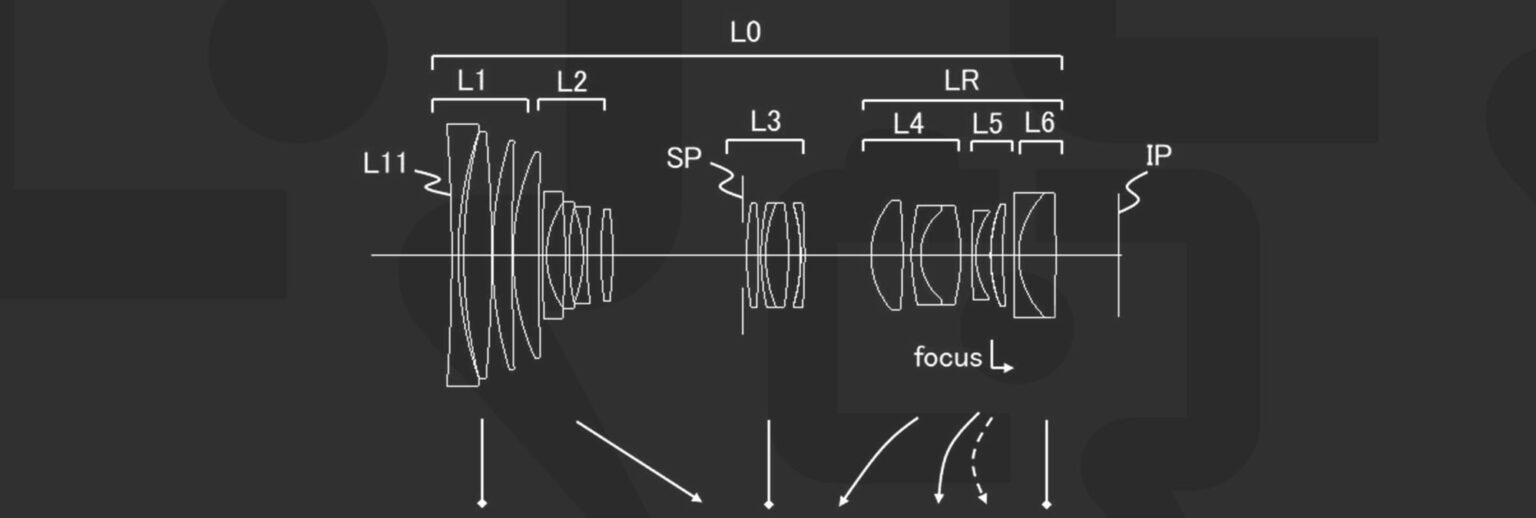This is the patent application (2024-079936) that shows off the Canon RF 24-105 F2.8 Z lens, so it’s unknown if this was a one-and-done patent application and the rest of the embodiments will never come out. But with Canon announcing two VR lenses for APS-C – who can say what Canon is thinking at this point?
This first embodiment is interesting because even though it’s a Z so will be big and heavy. But it’s a really sweet focal range that I would sell a kidney for. I’m going to call it a Z lens just because it’s huge, and has inner zoom and focus. It’s also extremely complex.
Canon RF-S 15-60mm F2.8 Z

| Wide | Medium | Telephoto | |
| Focal Length | 15.45 | 29.99 | 58.20 |
| F-Number | 2.90 | 2.90 | 2.90 |
| Half Angle of View | 41.5 | 24.4 | 13.2 |
| Lens Length | 144.55 | 144.55 | 144.55 |
| Back Focus Distance | 13.62 | 13.62 | 13.62 |
Also of interesting note is this full frame lens which is a monster in the same sentence as the Canon RF 24-105mm F2.8L IS USM Z. Though the focal range leaves me a bit questioning, I suspect that Canon for marketing reasons would call this a 21-80mm lens. It also features dual focusing motors well – just to add to that eye-watering price that such a lens would command.
Canon RF 22-80mm F2.8L Z

| Wide | Medium | Telephoto | |
| Focal Length | 22.60 | 43.42 | 82.99 |
| F-Number | 2.90 | 2.90 | 2.90 |
| Half Angle of View | 44.3 | 26.5 | 14.1 |
| Lens Length | 216.25 | 216.25 | 216.25 |
| Back Focus Distance | 11.83 | 26.43 | 22.33 |
As with all patent applications, none of these may end up as actual products, but it’s a glimpse into Canon’s ongoing research.
Source: Japan Patent Application 2024-079936
|
When you purchase through links on our site, we may earn an affiliate commission. Here's how it works. |


Everybody can make a lens with the same focal range, provided they do not copy Canon's optical design.
It’s just a good business practice, nothing malicious.
Basically, the patent is for a set of rules, or recipe, for designing a lens, and the embodiments shown are just examples of the recipe being put to use.
It's like, if I patented the rules for forming a sonnet, then gave a couple sonnets as examples. (A sonnet has this number of lines, this rhyme scheme, etc.) The patent covers the rules, not the embodiments.
The patent doesn't give those particular embodiments in the patent application any special protection. Any other use of the rules set in the patent is equally protected. (The embodiments are of course also protected, but not because they're shown in the doc, instead because they're designed to that set of rules.)
Now as to guessing what Canon comes out with next: it'd be interest for someone to go through Canon's lens history and determine which lenses were actually embodiments shown in patents, and which aren't. I wouldn't be shocked to hear it's anything from 0% to 100%. In Canon's shoes I think I wouldn't want to tip competitors as to what I was going to release. On the other hand maybe it's no secret. The industry is mostly Japanese, and Japanese industry is historically pretty well mutually-informed. The old famous MITI (Ministry of International Trade and Industry) used to basically order firms to share secrets, and it promoted a "convoy" system of a "fleet" of companies in an industry moving together for mutual protection. MITI turned into METI and I'm not sure how much they order around companies any more but the non-competitive mindset probably still exists. The goal was that if a firm had a killer idea, the whole industry might benefit from it, and if a strategy was a total dud, its originator wouldn't go bankrupt because the other firms would be doing the same thing. Likewise, employees move between firms to some extent too, carrying information. You may remember that Toyota's Lexus, Nissan's Infinity, Honda's Acura, and Mazda's Efini brands all popped up within a couple months of each other after years of long planning that likewise started within a few months of each other.
Ministry of International Trade and Industry - Wikipedia
not necessarily. this patent application also had the 24-105 F2.8 Z.
and cost too. patent lawyers are not cheap, and canon would have to have them in multiple countries to manage the patent applications turning into patents.
On the other hand: An R7 with 15-60 f/2.8 Z might be the same price, size and weight. So maybe financially in the same ballpark.
Only big advantage of R7: Auto levelling feature and maybe an add-on for the Z-lens to have electrical zoom in a moderately compact unit.
And what could that tell us about a potential release timeframe of the RF22-80 Z? (I know, not all patents become products, but how much time usually passes if the patent becomes a product)
And you’ve recently mentioned the RF15-35 Z which might be released this year. When has the patent for this RF15-35mm f/2.8 Z been filed?
it would tell us absolutely nothing about the timing.
I assumed it was only based on when the patent for the 15-35 Z was filed.
Do you know when the patent for the 24-105 Z was filed from the top of your head? Maybe to at least give us the slightest of hints of how long it roughly takes Canon from patent filing to product release
Sometimes, patents are applied to just prior to an announcement.
Other times, it can be years.